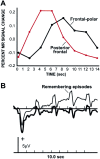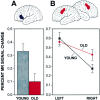Functional-anatomic correlates of control processes in memory - PubMed (original) (raw)
Review
Functional-anatomic correlates of control processes in memory
Randy L Buckner. J Neurosci. 2003.
No abstract available
Figures
Figure 1.
Frontal regions activated during memory retrieval show a roughly posterior to anterior gradient of functional specialization. Posterior regions (red) tend to modulate on the basis of retrieved content, and more anterior regions (blue) modulate based on the level and type of controlled processing demand. Frontal-polar regions(green) exhibit complex properties that are content independent and associated with high-level task goals (see text).
Figure 2.
During retrieval of specific episodes, frontal-polar regions demonstrate prolonged signal change, suggesting a contribution to temporally extended processes that establish a task set or retrieval mode. A, The time course of posterior and anterior frontal regions is shown from a functional magnetic resonance imaging study of memory retrieval. Note that the timescale(in seconds) reflects the temporal blurring of the hemodynamic response (Logethetis, 2003). Adapted from Schacter et al.(1997).B, The time course of evoked response potentials measured over anterior frontal scalp sites. A slowly evolving change in the waveform is noted during the periods of remembering that extends across individual items. Adapted from Düzel et al. (1999).
Figure 3.
Under-recruitment and nonselective recruitment of frontal regions in older adults are illustrated. A, Anterior left frontal regions are under-recruited in older adults as compared with younger adults during intentional memorization. B, Older adults, paradoxically, show increased activation in regions not typically associated with processing in younger adults (nonselective recruitment). In this example, young adults show selective recruitment of left posterior frontal regions during word encoding. Older adults show greater relative activation of the homologous right frontal region. Adapted from Logan et al (2002). See Cabeza (2002) and Reuter-Lorenz (2002) for additional examples.
Similar articles
- Inferior temporal, prefrontal, and hippocampal contributions to visual working memory maintenance and associative memory retrieval.
Ranganath C, Cohen MX, Dam C, D'Esposito M. Ranganath C, et al. J Neurosci. 2004 Apr 21;24(16):3917-25. doi: 10.1523/JNEUROSCI.5053-03.2004. J Neurosci. 2004. PMID: 15102907 Free PMC article. - Ventrolateral prefrontal cortex and tactile memory disambiguation in the human brain.
Kostopoulos P, Albanese MC, Petrides M. Kostopoulos P, et al. Proc Natl Acad Sci U S A. 2007 Jun 12;104(24):10223-8. doi: 10.1073/pnas.0700253104. Epub 2007 Jun 5. Proc Natl Acad Sci U S A. 2007. PMID: 17551017 Free PMC article. - Prefrontal cortex and working memory processes.
Funahashi S. Funahashi S. Neuroscience. 2006 Apr 28;139(1):251-61. doi: 10.1016/j.neuroscience.2005.07.003. Epub 2005 Dec 1. Neuroscience. 2006. PMID: 16325345 Review. - Working memory and prefrontal cortex.
Funahashi S, Kubota K. Funahashi S, et al. Neurosci Res. 1994 Nov;21(1):1-11. doi: 10.1016/0168-0102(94)90063-9. Neurosci Res. 1994. PMID: 7708289 Review. - Specialization in the left prefrontal cortex for sentence comprehension.
Hashimoto R, Sakai KL. Hashimoto R, et al. Neuron. 2002 Aug 1;35(3):589-97. doi: 10.1016/s0896-6273(02)00788-2. Neuron. 2002. PMID: 12165479
Cited by
- Retrieval search and strength evoke dissociable brain activity during episodic memory recall.
Reas ET, Brewer JB. Reas ET, et al. J Cogn Neurosci. 2013 Feb;25(2):219-33. doi: 10.1162/jocn_a_00335. Epub 2012 Nov 28. J Cogn Neurosci. 2013. PMID: 23190328 Free PMC article. - Between-task competition and cognitive control in task switching.
Yeung N, Nystrom LE, Aronson JA, Cohen JD. Yeung N, et al. J Neurosci. 2006 Feb 1;26(5):1429-38. doi: 10.1523/JNEUROSCI.3109-05.2006. J Neurosci. 2006. PMID: 16452666 Free PMC article. - Dissociable correlates of two classes of retrieval processing in prefrontal cortex.
Ranganath C, Heller AS, Wilding EL. Ranganath C, et al. Neuroimage. 2007 May 1;35(4):1663-73. doi: 10.1016/j.neuroimage.2007.01.020. Epub 2007 Feb 3. Neuroimage. 2007. PMID: 17368914 Free PMC article. - Memory monitoring performance and PFC activity are associated with 5-HTTLPR genotype in older adults.
Pacheco J, Beevers CG, McGeary JE, Schnyer DM. Pacheco J, et al. Neuropsychologia. 2012 Jul;50(9):2257-70. doi: 10.1016/j.neuropsychologia.2012.05.030. Epub 2012 Jun 13. Neuropsychologia. 2012. PMID: 22705442 Free PMC article. - Evidence for a functional subdivision of Premotor Ear-Eye Field (Area 8B).
Lanzilotto M, Perciavalle V, Lucchetti C. Lanzilotto M, et al. Front Behav Neurosci. 2015 Jan 30;8:454. doi: 10.3389/fnbeh.2014.00454. eCollection 2014. Front Behav Neurosci. 2015. PMID: 25688190 Free PMC article.
References
- Arnsten AFT, Cai JX, Murphy BL, Goldman-Rakic PS ( 1994) Dopamine D-1 receptor mechanisms in the cognitive performance of young-adult and aged monkeys. Psychopharmacology 116: 143–151. - PubMed
- Balota DA, Dolan PO, Duchek JM ( 2000) Memory changes in healthy older adults. In: The Oxford handbook of memory (Tulving E, Craik FIM, eds), pp 395–410. New York: Oxford UP.
- Braver TS, Bongiolatti SR ( 2002) The role of frontopolar cortex in subgoal processing during working memory. NeuroImage 15: 523–536. - PubMed
- Braver TS, Barch DM, Keys BA, Carter CS, Cohen JD, Kaye JA, Janowsky JS, Taylor SF, Yesavage JA, Munenthaler MS, Jagust WJ, Reed BR ( 2002) Context processing in older adults: evidence for a theory relating cognitive control to neurobiology in healthy aging. J Exp Psychol 130: 746–763. - PubMed
Publication types
MeSH terms
LinkOut - more resources
Full Text Sources
Medical


